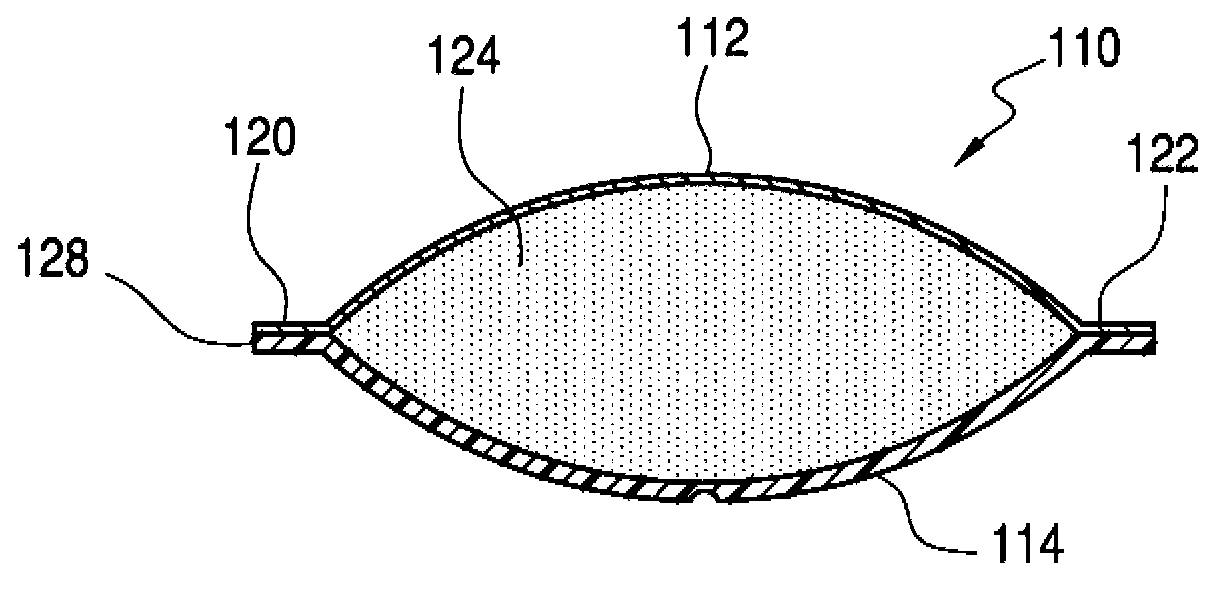Method of forming a pouch
A bag-like body, film bag technology, applied in the direction of surface-coating liquid devices, liquid materials, flexible tubular containers, etc., can solve problems such as ineffectiveness, foil or wrapping cannot be tightly and densely wrapped, etc.
- Summary
- Abstract
- Description
- Claims
- Application Information
AI Technical Summary
Problems solved by technology
Method used
Image
Examples
Embodiment 1
[0071] Package samples were evaluated to determine the design for dispensing the sticky material.
[0072] The sample is made of transparent polypropylene Package body, thin (<1mm) black polypropylene and polyethylene sheet and acrylic resin film (<1mm) construction. Sheets were formed and heat sealed into package shapes by first cutting oversized top and bottom rectangles with triangular ends and heat sealing the sheet with the triangular ends on one side to form the nozzle. Some packages are formed with gussets. The gusset is formed by folding the film at the sides and bottom of the pack.
[0073] Excess material is trimmed from the package after forming. Each package is filled with material and then heat sealed to form a seal. The package has a length of about 4 cm to 20 cm, a width of about 2 cm to 15 cm and a thickness (filled with material) of about 0.5 cm to 2 cm. The package body is filled with acrylic caulk or silicone sealant.
[0074] A panel of aggregated ra...
Embodiment 2
[0080] The resulting design was functionally tested by others representing the consumer panel. The 10 designed packages were distributed among the 6 people in the group. Each was taught to press the material out of the package according to the steps of folding the package longitudinally along the crease with the index finger of one hand and manually pressing the package to force the sealant out of the package nozzle.
[0081] A designer panel observed the extrusion process and recorded the panel's comments. Consumer panel responses were photographed to collect package usage and comments.
[0082] The team approves the proposed design. Record the following group's comments on the design: "This is really nice! I'm looking for it". "I think it's the astonishing type. All I can say is it's good stuff." "Very easy to use. I love the beads it gives me. Feels like I have a lot of control". "I've loved it, and I'm going to tell you why. Because you can really manipulate the press...
Embodiment 3
[0085] This example describes iterative evaluation of a series of package samples to determine the best harder material.
[0086] First, for production performance, a range of materials were evaluated, including paperboard, plastic sheet and corrugated fiberboard. The sample paperboard caliper was about 0.010" to 0.100"; the high density polyethylene sheet (HDPE) was about 0.005" to 0.100" caliper; and the corrugated fiberboard corrugation was B-channel to N-channel.
[0087] User evaluations determined that paperboard having a thickness of less than about 0.080" was not sufficiently rigid for acceptable dispensing and "ease of use". Thicker paperboard yielded improved performance results but was rated as unacceptable due to its bulky feel. Thinner HDPE samples with a thickness below 0.040" were rated as unacceptable due to insufficient stiffness. Thicker HDPE samples showed improved performance but increased cost.
[0088] The performance of corrugated fiberboard is best i...
PUM
| Property | Measurement | Unit |
|---|---|---|
| thickness | aaaaa | aaaaa |
| thickness | aaaaa | aaaaa |
| thickness | aaaaa | aaaaa |
Abstract
Description
Claims
Application Information
 Login to View More
Login to View More - R&D
- Intellectual Property
- Life Sciences
- Materials
- Tech Scout
- Unparalleled Data Quality
- Higher Quality Content
- 60% Fewer Hallucinations
Browse by: Latest US Patents, China's latest patents, Technical Efficacy Thesaurus, Application Domain, Technology Topic, Popular Technical Reports.
© 2025 PatSnap. All rights reserved.Legal|Privacy policy|Modern Slavery Act Transparency Statement|Sitemap|About US| Contact US: help@patsnap.com



